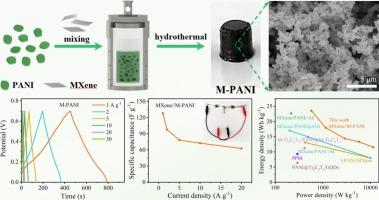柔性非对称超级电容器用mxene修饰和电化学增强聚苯胺水凝胶
IF 8.9
2区 工程技术
Q1 ENERGY & FUELS
引用次数: 0
摘要
高效制备具有优异电化学性能的聚苯胺(PANI)超级电容器电极材料对于其在储能器件中的应用至关重要,尽管其中存在困难。我们开发了一种直接水热组装方法,利用高导电MXene修饰的聚苯胺分散体来构建MXene修饰的聚苯胺水凝胶(M-PANI)。研究结果表明,水热处理MXene纳米片的分解和部分MXene转化为TiO2可以显著提高M-PANI水凝胶的电化学性能。制备的M-PANI水凝胶电极具有较高的比电容(在1 A g−1时为483.1 F g−1),优越的倍率能力(从1到20 A g−1时为79.8%)和宝贵的循环耐久性(在6000次循环后为初始电容的80%)。以MXene为阳极,M-PANI为阴极,制备了柔性非对称超级电容器(MXene//M-PANI),具有较高的比电容(1 A g−1时为128.2 F g−1),满足能量密度(575 W kg−1时为23.6 W h kg−1)和良好的循环耐久性(9000次循环后初始电容保持率为89.4%)。制备的m -聚苯胺水凝胶作为超级电容器电极具有优异的电化学性能,在尖端储能技术领域具有巨大的潜力。本文章由计算机程序翻译,如有差异,请以英文原文为准。

MXene-modified and electrochemically enhanced polyaniline hydrogels for flexible asymmetric supercapacitors
Efficiently preparing polyaniline (PANI) supercapacitor electrode materials with exceptional electrochemical performance is vital for their utilization in energy storage devices, notwithstanding the difficulties involved. We developed a direct hydrothermal assembly approach to construct MXene-modified PANI hydrogel (M-PANI) using PANI dispersion modified by highly conductive MXene. The findings suggest that the breakdown of MXene nanosheets and the conversion into TiO2 from part of MXene by hydrothermal treatment may notably boost the electrochemical performances of M-PANI hydrogels. The prepared M-PANI hydrogel electrodes exhibit high specific capacitance (483.1 F g−1 at 1 A g−1), superior rate capability (79.8 % from 1 to 20 A g−1), and valuable cycling durability (80 % of initial capacitance after 6000 cycles). The flexible asymmetric supercapacitors (MXene//M-PANI) were further assembled using MXene as anode and M-PANI as cathode materials, which achieve high specific capacitance (128.2 F g−1 at 1 A g−1), satisfying energy density (23.6 W h kg−1 at 575 W kg−1), and favorable cycling durability (89.4 % retention of the initial capacitance after 9000 cycles). The generated M-PANI hydrogels with remarkable electrochemical performances as supercapacitor electrodes suggest their enormous potential in the field of cutting-edge energy storage technology.
求助全文
通过发布文献求助,成功后即可免费获取论文全文。
去求助
来源期刊

Journal of energy storage
Energy-Renewable Energy, Sustainability and the Environment
CiteScore
11.80
自引率
24.50%
发文量
2262
审稿时长
69 days
期刊介绍:
Journal of energy storage focusses on all aspects of energy storage, in particular systems integration, electric grid integration, modelling and analysis, novel energy storage technologies, sizing and management strategies, business models for operation of storage systems and energy storage developments worldwide.
 求助内容:
求助内容: 应助结果提醒方式:
应助结果提醒方式:


